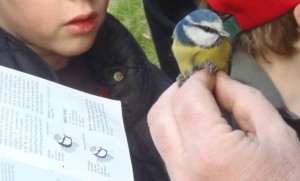
Bird ringing is essential to the development of both bird science and bird conservation. It dates back to 1899 when the first metal rings carrying a unique number were attached to the leg of a bird. This innovation turned anonymous birds into recognisable individuals, identifiable as such for the rest of their lives. Ringing soon became a mainstay of migration studies worldwide, revealing previously unknown migration routes to an astonished world. Later on, in the 1940s, ring-recoveries came to be used to estimate annual survival rates of birds.
Large numbers of birds must usually be ringed in order to provide a small number of recoveries, with the average recovery rate for birds ringed in Britain around 2%. Most small birds have recovery rates of less than 1% (excluding personal recaptures by the ringers themselves), but some larger birds can yield recovery rates of 20% or more. Many records are needed to provide a worthwhile picture of the migration routes or survival rates of particular species.
Ringing can be applied to species of any size, year after year, on a large spatial scale (nationwide or greater), with the results continually added to an ever-growing long-term database. Moreover, the biometrics collected when birds are handled in large numbers provide valuable insight into other aspects of bird biology, such as breeding and moult, body weights, age and sex ratios, and even the incidence of disease.
Ringing data have shown their value in recent decades, when many bird populations declined and some species have also changed their migration patterns. If we are to detect and understand these changes, and take effective conservation measures, we need appropriate data. The most recent BTO studies combine data from ringing, nest records and counting schemes to produce demographic models of bird populations that give unprecedented detail on large-scale population dynamics. Understanding what is happening to our bird species will help direct efforts in bird conservation.
Mid Ulster Bird Ringing Project
One of the objectives of the Mid Ulster Biodiversity Action Plan is to engage local people in action for our local biodiversity. One aspect of this is to encourage the observation and recording of our local species. Previous training projects have been well supported with local people now taking part and gathering vital information through a range of surveys for bats, butterflies, moths, bumblebees, etc.
Bird ringing provides vital information that cannot be obtained from bird observations alone. However, bird ringing is highly regulated and can only be carried out by skilled licensed ringers with the utmost consideration for the birds’ welfare. Learning as an ‘apprentice’ (for usually a couple of years) under the close supervision of experienced ringers, progress is assessed by an independent ringer so the Ringing Scheme maintains very high standards of bird welfare and scientific data. A British Trust for Ornithology ringing permit is a legal requirement for anyone ringing birds. It has to be renewed annually.
There are licensed bird ringers within Northern Ireland, however, few operate ‘West of the Bann’. Consequently, there is a lack of data on bird species in the Mid Ulster area that could be obtained through ringing. This information would be particularly beneficial in shaping future conservation work both through and outside the Mid Ulster Biodiversity Action Plan.
To address this situation the “Mid Ulster Bird Ringing Project” is being developed in partnership with trained licensed bird ringers. The objective of the project is to bring together people interested in becoming a licensed ringer, and to provide training opportunities to enable them to do so. Through this process, vital data will be obtained on a range of bird species frequenting the Mid Ulster area.
The outcome of the project will be to have trained bird ringers operating in the Mid Ulster area, gathering vital information that will be of use at local, national and international levels.
It is intended to run a series of training days over the next couple of years throughout the Mid Ulster area. A number of sites have been identified across a range of habitat types that should enable the trainees to experience ringing a selection of bird species. This will contribute to the knowledge and skills required to enable a trainee to undergo an assessment on their competence for obtaining a ringing license. Trainees through the Mid Ulster Bird Ringing Project will be encouraged to take part in ringing outside the area, which will provide a wider experience of habitats, bird species, and ringing techniques. Similarly, ringers from outside the area will be welcome to attend any of the events organised through the Mid Ulster Bird Ringing Project.
Although dates and locations have yet to be finalised it is envisaged that there will be 6-8 events across 3-4 sites in 2015. A similar number of events will be held next year, with the location of these being determined following an assessment of the ringing results from this year.
If you have an interest in becoming a ringer, or even want to come along to see what it is all about, please contact Mark Edgar, Biodiversity Officer, Mid Ulster District Council.
E-mail: mark.edgar@midulstercouncil.org


